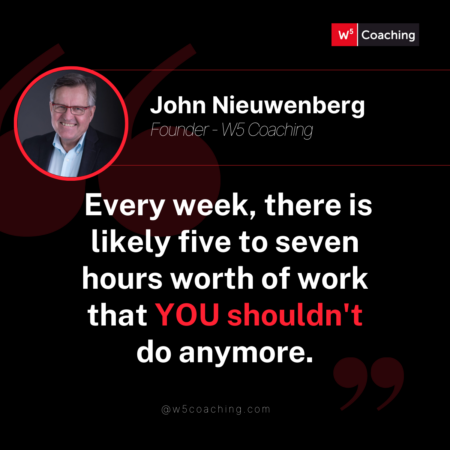From Operator to Owner: How Construction Business Owners Buy Back Their Time

I recently joined Martin Holland and Khalil Benalioulhaj on the Cash Flow Contractor podcast for a conversation about time, team, and money — the three areas where most owners get stuck.
While the show is aimed at contractors, the lessons apply to any small business owner who wants a company that runs profitably, and mostly without them.
If you own a business, there’s a good chance you’re spending 5–7 hours every week on work you shouldn’t be doing. That’s not a character flaw—it’s the predictable outcome of growing a business faster than you grow your systems, bench strength, and leadership habits.
Most owners I meet are wrestling with some mix of these three constraints:
- Time: “I’ve got too much to do and not enough time. If I don’t do it, it won’t get done.”
- Team: “It’s hard to recruit. It’s hard to get people to the standard I need.”
- Money: Either the numbers aren’t clear (no dashboards/KPIs), or sales and margins aren’t where they need to be.
You don’t fix those by working harder. You fix them by changing what you work on.
Step 1: Start with Your “Oh, Sh*t List”
When you think about it, you already know which tasks don’t belong on your plate. I call it the “Oh, Sh*t List”—the recurring work that triggers a little “oh, sh*t” every week:
- Invoicing and receivables calls
- Payroll and paperwork
- Chasing signatures or sending out proposals
- Estimates that stall because you’re buried in everything else
Those tasks are signals. If they trigger dread, procrastination, or constant context-switching, you shouldn’t be doing them.
What to do instead
- Delegate the outcome, not just the task. Record a 15–30 minute screen-share (Zoom works fine) showing exactly how you want it done.
- Have the assistant write the SOP. Their first job is to draft the step-by-step. That accomplishes three things at once:
- It forces clarity (you’ll both see what “done right” looks like).
- It creates a reusable standard for next time or for backfill.
- It reduces your involvement to quick reviews, not doing the work.
- Pay the right rate for the right work. If your billable value is $100–$150/hr and there’s competent help available at a fraction of that, you don’t need another reason.
Owners balk at the “five hours” it takes to teach someone. Think of it as a capital investment that pays back an hour a week for the rest of your life.
Step 2: Ask a Better Question About Getting Things Done
Most owners ask, “How can I get this done?” That question traps you in operator mode.
A better question is: “How can this get done” (and not by me?)
When you switch the question, you start to build leverage through:
- People: assistants, coordinators, bookkeepers, estimators
- Process: SOPs, checklists, templates
- Technology: simple tools that standardize and speed up
Leverage is how you do more with less of your time.
Step 3: Protect Your Attention with a Default Diary
You don’t just run out of time—you run out of attention. Rings, pings, and dings consume the day unless you decide what gets your best brain, and when.
Use a Default Diary (time-blocking that repeats weekly):
- Define results: What 2–3 outcomes matter most this week?
- Define activities: What work produces those outcomes?
- Define volume: How many blocks do you need?
- Schedule it: Put those blocks in first. Everything else works around them.
A simple structure I like:
- Daily 30-minute triage with your assistant at the start of the day to clear the inbox/rings/pings and assign tasks.
- One or two 90-minute deep-work blocks (uninterrupted) for estimates, sales conversations, or leadership work that only you can do.
- 10-minute end-of-day reset to adjust tomorrow’s plan.
Emergencies happen. Three a month is real life. Three a week is a systems problem.
Your calendar should be sacred. Offer clients options that fit your blocks (e.g., “I meet Tuesday mornings or Thursday afternoons—what works best?”).
Boundaries increase respect and productivity.
Step 4: Build Your Bench Before You Need It
Owners put enormous effort into acquiring customers—and very little into acquiring the next team member. That’s why a sudden resignation puts the whole business off balance.
Always be recruiting. Build a farm team for every key role:
- Keep an informal list of 5–10 Red Seal electricians (or equivalent) you’ve met, had coffee with, or observed on jobsites.
- Show up where they are—associations, supplier counters, community events.
- Consider a part-time recruiter (Upwork works) for a few hours a month to discreetly source and pre-qualify talent.
The person with the most options has the most leverage. When you have a bench:
- You stop tolerating chronic underperformance.
- You can have the necessary conversations without fear.
- You can say “yes” to more work because you can staff it.
Step 5: Culture Is Not the Cherry on Top
You don’t get the culture you want. You get the culture you deserve—the one your systems, standards, and hiring practices create.
A quick diagnostic: If you could rehire your current team from scratch today, how many would make the cut?
If the answer is “about half,” you already know where the friction and customer issues come from. Your bench—and your standards—solve this.
Every owner should ask, “What’s the one thing I do that only I can do?”
In my case, it’s conversations with clients and prospects. Everything else must be delegated, documented, or deleted.
That’s the real shift from operator to owner:
- Delegate your “Oh, Sh*t List.”
- Codify your standards (SOPs).
- Protect attention with a Default Diary.
- Build your bench before you need it.
- Lead the culture you deserve.
Do that, and you’ll have less stress, more time, and more money—with a business that runs because of your systems, not your heroics.
Want help implementing this in your business?
I coach three days a week because I still love the work and the wins owners get from these changes. If you’re ready to buy back your time and build a self-managing business, Book a free 15-minute call with me. We’ll talk about what’s going on in your business and see how I can help.

Build a Self-Managing Company
How to build a business that runs smoothly, profitably, and (mostly) without you.
Feeling stressed out and overwhelmed with a business that is taking all your time - and not giving you enough in return?
Are you finding it challenging to hire the right team (and get them to do the right things)?
I wrote this little guide for you!
Enter your details below to receive your free copy!
